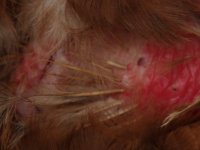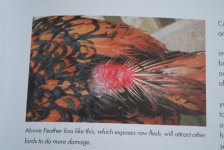rick
Active member
** In the end it wasn't vent gleet. Best guess: it was feather pecking by the rest of the flock caused by her laying shell-less eggs. See 'Big Egg' and 'Implant for Blaze'. Will recognise vent gleet if it happens now though!**
As a relatively new chicken keeper there are lots of minor issues that I assume are just one of those things that come and go -
Like occasional looser droppings and some feathers missing from the underside of a hen.
But in the past few days the red skin on the underside of Blaze (and Betty to a lesser extent) has been a niggling problem that I felt must be connected with her somewhat wrinkly eggs of late. After a discussion with the vet today we are confident that it is a case of vent gleet.
Now I’m remembering that Brownie often had a messy bottom (from quite young, not all the time but quite often - I had come to think that was just how she was.)
Fortunately Blaze has stopped laying and we are getting some Nystatin (or similar) to clear up any fungal infection tomorrow.
I really hope this sorts out her and Betty who have had very few feathers under the vent for quite a while. They also had lice but I’m now thinking that was a secondary thing.
But what I’ve defiantly learnt from this is that messy bottoms leading to missing feathers is not just one of those things. We will have fluffy rears again!
I’m trying to think why this happened in the first place - the run is covered and I’m quite careful about changing food and water daily. I read one recommendation of not allowing drinkers to become green and slimy - well blow me down, you don’t say!!
Maybe the environment here is a little more prone to yeast growth - a bit too sheltered (?)
To many grapes? Surely not (hmmm? we are fond of a grape or three)
Note from Teabag - do not withdraw all grapes on this very circumstantial evidence. My bottom is quite fluffy thank you very much!
As a relatively new chicken keeper there are lots of minor issues that I assume are just one of those things that come and go -
Like occasional looser droppings and some feathers missing from the underside of a hen.
But in the past few days the red skin on the underside of Blaze (and Betty to a lesser extent) has been a niggling problem that I felt must be connected with her somewhat wrinkly eggs of late. After a discussion with the vet today we are confident that it is a case of vent gleet.
Now I’m remembering that Brownie often had a messy bottom (from quite young, not all the time but quite often - I had come to think that was just how she was.)
Fortunately Blaze has stopped laying and we are getting some Nystatin (or similar) to clear up any fungal infection tomorrow.
I really hope this sorts out her and Betty who have had very few feathers under the vent for quite a while. They also had lice but I’m now thinking that was a secondary thing.
But what I’ve defiantly learnt from this is that messy bottoms leading to missing feathers is not just one of those things. We will have fluffy rears again!
I’m trying to think why this happened in the first place - the run is covered and I’m quite careful about changing food and water daily. I read one recommendation of not allowing drinkers to become green and slimy - well blow me down, you don’t say!!
Maybe the environment here is a little more prone to yeast growth - a bit too sheltered (?)
To many grapes? Surely not (hmmm? we are fond of a grape or three)
Note from Teabag - do not withdraw all grapes on this very circumstantial evidence. My bottom is quite fluffy thank you very much!



